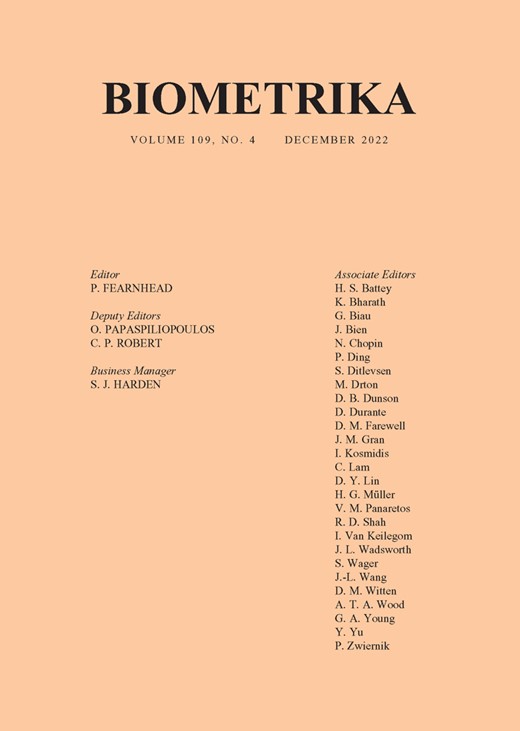-
PDF
- Split View
-
Views
-
Cite
Cite
Alexander Henzi, Johanna F Ziegel, Correction to: ‘Valid sequential inference on probability forecast performance’, Biometrika, Volume 109, Issue 4, December 2022, Pages 1181–1182, https://doi.org/10.1093/biomet/asac043
Close - Share Icon Share
In the paragraph before Proposition 2 of Henzi & Ziegel (2021) it is claimed that is a nonnegative supermartingale. This is generally not true for |$h \,{>}\, 1$|. As a consequence, Proposition 2 is not correct for |$h > 1$|, and should be adapted as follows.
$$
e_T = \frac{1}{h}\sum_{k=1}^h\prod_{l \in I_k}E_{p_l,\ q_l;\lambda_l}(Y_{l+h}), \quad I_k = \{k + hs\colon s = 0, \dots \lfloor (T-k)/h\rfloor - 1\},
$$
Proposition 2.
Let |$\tau \in \mathbb{N}$| be a stopping time. Then under the assumptions of Proposition 1,
$$
\mathbb{E}_{\mathbb{Q}}(e_{\tau + h - 1}) \leqslant 1, \quad \mathbb{Q} \in \mathcal{H}_{{\rm S}}.
$$
The quantity |$p_{t_0} = \min\{1, \inf_{s = 1, \dots, t_0} 1/e_s\}$| defined in the last paragraph of § 3 is an anytime-valid |$p$|-value only for |$h = 1$|, but the stopping time |$\tau_{\alpha,h}$| guarantees that |$\mathbb{Q}(\tau_{\alpha,h} < \infty) \leqslant \alpha$| for |$h > 1$|, |$\alpha \in (0,1)$|, and |$\mathbb{Q}\in \mathcal{H}_{{\rm S}}$|, because |$\tau_{\alpha,h} < \infty$| implies |$e_{\tau_{\alpha,h} + h - 1} \geqslant 1/\alpha$|. Hence all empirical results in the article remain valid. An anytime-valid |$p$|-value for |$h > 1$| is given by since |$p_{t} \leqslant \alpha$| for some |$t \in \mathbb{N}$| if and only if |$\tau_{\alpha,h} < \infty$|.
$$
p_{t_0} = \min\left(1, \inf_{s = 1, \dots, t_0} \left[\max_{j = s - h + 1, \dots, s - 1} \! E_{p_{j}, q_{j}; \lambda_j}\{{\rm 1}\kern-0.24em{\rm I}(p_{j} > q_{j})\}^{-1}/e_{s}\right]\right),
$$
Proof of Proposition 2.
Recall that the process |$(Y_t, p_t, q_t, \lambda_t)_{t \in \mathbb{N}}$| is adapted to |$\mathfrak{F} = (\mathcal{F}_t)_{t \in \mathbb{N}}$|. Let |$h > 1$|. For |$k = 1, \dots, h$|, define |$I_k(t) = \{k + hs\colon s = 0, \dots \lfloor (t-k)/h\rfloor - 1\}$|, with |$\prod_{\emptyset} := 1$| and |$\mathcal{F}_j := \{\Omega, \emptyset\}$| for |$j \leqslant 0$|. Then |$e_t = \sum_{k=1}^h M^{[k]}_t/h$|. For |$k = 1, \dots, h$|, the process |$(M^{[k]}_t)_{t \in \mathbb{N}}$| is a nonnegative supermartingale with respect to |$\mathfrak{F}^{[k]}$| for any |$\mathbb{Q} \in \mathcal{H}_{{\rm S}}$|, and therefore satisfies |$\mathbb{E}_{\mathbb{Q}}(M^{[k]}_{\tau[k]}) \leqslant 1$| for any |$\mathfrak{F}^{[k]}$|-stopping time |$\tau^{[k]}$|. So for |$\mathfrak{F}^{[k]}$|-stopping times |$\tau^{[k]}$|, |$k = 1,\dots,h$|. If |$\tau$| is an |$\mathfrak{F}$|-stopping time, then is an |$\mathfrak{F}^{[k]}$|-stopping time. To see this, let |$t = k + hs + j$| for |$s \in \mathbb{N}_0$|, |$k \in \{1, \dots, k\}$|, |$j \in \{0, \dots, h-1\}$|. Then |$\lfloor(t-k)/h\rfloor h+k = k + hs$|, and |$f_k(\tau) \leqslant t$| if and only if |$\tau \leqslant k+hs$|, so
$$
M^{[k]}_t = \prod_{l \in I_k(t)} E_{p_{l},q_{l};\lambda_{l}}(Y_{l+h}), \quad
\mathfrak{F}^{[k]} = \left(\mathcal{F}_{\lfloor \frac{t-k}{h}\rfloor h + k}\right)_{t \in \mathbb{N}},
$$
$$
\mathbb{E}_\mathbb{Q}\left(\frac{1}{h}\sum_{\ell=1}^h M^{[k]}_{\tau^{[k]}}\right) \leqslant 1.
$$
$$
\left(\left\lfloor\frac{\tau-k-1}{h}\right\rfloor + 1\right)h + k =: f_k(\tau) \in \{\tau, \dots, \tau + h - 1\}
$$
$$
\{f_{k}(\tau) \leqslant t\} = \{\tau \leqslant k + hs\} \in \mathcal{F}_{k+hs} = \mathcal{F}_{\lfloor \frac{t-k}{h}\rfloor h + k}.
$$
This implies that for any |$\mathfrak{F}$|-stopping time |$\tau$|, we obtain using the fact that |$M_{t + h - 1} = \sum_{k=1}^h M^{[k]}_{f_k(t)}/h$| for |$t \in \mathbb{N}$|. □
$$
\mathbb{E}_{\mathbb{Q}}(M_{\tau + h - 1}) = \mathbb{E}_\mathbb{Q}\left(\frac{1}{h}\sum_{k=1}^h M^{[k]}_{f_k(\tau)}\right) \leqslant 1, \quad \mathbb{Q} \in \mathcal{H}_{{\rm S}},
$$
The following example demonstrates that the statement of Proposition 2 with |$\tau$| instead of |$\tau + h - 1$| is not true. Let |$h = 2$|, |$\varepsilon \in (0,1)$|, and |$\delta \in (0, \varepsilon)$|. Define |$p_1 = \varepsilon-\delta$|, |$q_1 = \varepsilon+\delta$|, and |$p_t = q_t = 0.5$| for |$t > 1$|. Let |$S(p,y) = (p-y)^2$|. Then the one-period e-value for |$t = 1$| equals with |$\pi_{1,1} \in (\varepsilon, 1]$|, and |$E_{p_t,q_t}^{\pi_{1,t}}(y) \equiv 1$| for |$t > 1$|, which gives
$$
E_{p_1,q_1}^{\pi_{1,1}}(y) = \frac{\pi_{1,1}^{y}(1-\pi_{1,1})^{1-y}}{\varepsilon^y(1-\varepsilon)^{1-y}},
$$
$$
e_t = \begin{cases}
1, & \ t = 1, 2, \\
0.5E_{p_1,q_1}^{\pi_{1,1}}(Y_3) + 0.5, & \ t \geqslant 3.
\end{cases}
$$
The null hypothesis consists of all distributions |$\mathbb{Q}$| generating the sequence |$(Y_t)_{t \in \mathbb{N}}$| such that |$\mathbb{Q}(Y_3 = 1 \mid Y_1) \leqslant \varepsilon$|. Define |$\mathbb{Q}$| as follows. Let |$\mathbb{Q}(Y_1 = 1)$| be arbitrary; |$Y_2$|, |$Y_3$| independent of |$Y_1$| with |$Y_2 = Y_3$| almost surely and |$\mathbb{Q}(Y_2 = Y_3 = 1) = p \in (0, \varepsilon]$|; and |$Y_t$| for |$t > 3$| with arbitrary distribution. Define the stopping time |$\tau = 3Y_2 + 2(1-Y_2)$|. Then, so that |$\mathbb{E}_{\mathbb{Q}}(e_{\tau}) > 1$| for |$\pi_{1,1} > \varepsilon$|, since |$\mathbb{Q}(Y_2 = 1) = p > 0$|.
$$
e_{\tau} = \begin{cases}
1, & \ Y_2 = 0, \\
0.5\pi_{1,1}/\varepsilon + 0.5, & \ Y_2 = 1,
\end{cases}
$$
References
Henzi, A. & Ziegel, J. F. (
2021
). Valid sequential inference on probability forecast performance
. Biometrika
109
, 647
–63
.© 2022 Biometrika Trust
This is an Open Access article distributed under the terms of the Creative Commons Attribution License (https://creativecommons.org/licenses/by/4.0/), which permits unrestricted reuse, distribution, and reproduction in any medium, provided the original work is properly cited.
Issue Section:
Correction


